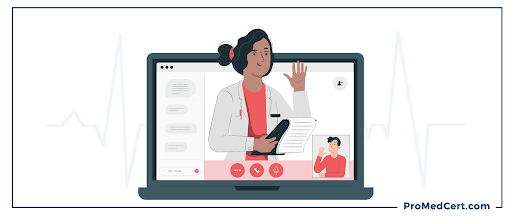Diagnosing During a Pandemic: Five Telehealth Tips

The COVID-19 pandemic has drastically changed the way that physicians practice medicine. While it is extremely important to practice social distancing whenever possible in order to prevent the spread of the virus, treating a patient who is not physically in the office with you can present some challenges. Here are a few things to consider when preparing for a telehealth appointment with a patient.
Privacy
Make sure that you’ve chosen a platform that allows the patient to have privacy. You’ll want to ensure that you’re using a reliable service if you’re having a video appointment, and you may want to increase your cybersecurity to avoid compromising confidential patient information. If you’ll be calling the patient on the phone, make sure that you confirm with them which number is best to reach them at — whether it’s their mobile, home, or office number. Ensure that you have their permission to leave voicemails at that phone number if you think this might be necessary. If your patient is uncomfortable discussing their health issues in front of others, remind them to go to a private space for the appointment. And of course, make sure that your own workspace remains private while you confer with your patient.
Some patients may prefer having a loved one with them during their virtual appointments, such as a spouse, parent, or caregiver. If this is the case, simply make sure that you have the patient’s permission to disclose their information to whomever is listening. Just as with in-person appointments, sometimes it can be helpful to have another person present to make note of medical advice.
Examination Methods
You may have to think outside the box when it comes to examining your patient virtually. If a patient has a rash or skin condition, they may be able to either take a photo of the affected area or show you using a video platform. Getting a detailed description and asking some very specific questions may be enough to arrive at a diagnosis in some cases.
However, keep in mind that some health problems simply need to be seen in person. If an illness is pressing and can’t be diagnosed via phone or video, don’t be afraid to ask a patient to come for an in-person appointment. If your patient is uncomfortable coming in, it may be helpful to remind them of all the safety precautions that are in place at your clinic. Sometimes it will be necessary to evaluate the potential health risks in order to decide on the best course of action. Which would be worse for your patient: coming in for an appointment and potentially being exposed to COVID-19? Staying home and allowing their current health condition to worsen? The answer will vary from patient to patient, so use your instincts to decide what’s best for them.
Put the Patient At Ease
A virtual appointment is going to feel a little different for both doctor and patient, so do whatever you can to make the transition easier, especially if you know that this is a patient’s first virtual appointment. Not everyone is tech-savvy, so make sure that if you use a video platform, it is easy to understand and all of your patients receive clear step-by-step instructions prior to their appointment. Older patients or those without a reliable Internet connection may be more comfortable with a phone appointment, so make sure they know that a phone call is an option. During the appointment, don’t be afraid of a little small talk to make sure your patient is comfortable. Sometimes the smallest details can put a patient more at ease — make sure that your background is neutral and professional, and that you’re wearing your white coat. If a patient seems nervous, you can always ask them if there’s anything you can do to make them feel more comfortable.
Know the History
Some things remain consistent, whether you’re treating someone virtually or with an in-person appointment. Always review the patient’s medical history prior to their appointment, and be sure to properly document any virtual or telehealth appointments so that your records remain up to date.
Consider carefully before taking on a new patient virtually or over the phone. It can be much more difficult to diagnose someone virtually if you’ve never treated them before, and getting to know a patient can be more challenging when it isn’t in-person. If you do take on any new patients, be sure to obtain as much information from them as possible prior to their first appointment. Getting a sense of their medical history could really help to determine the best course of treatment.
Insurance
Every insurance company is different when it comes to telemedicine, and many companies have different levels of coverage for virtual appointments than they do for in-person appointments. Find out as much as you can about how insurance companies are covering telehealth appointments during the pandemic, and make sure that each patient you treat is aware that their insurance may cover virtual appointments differently.
Telehealth appointments can be frustrating, especially when it feels like it’s more difficult to communicate with patients or you can’t execute a quality examination in a virtual format. But it’s important to remember that telemedicine has numerous benefits. Not only does it protect both healthcare workers and patients from COVID-19, but it also saves time and makes appointments more accessible.
Consider the next few years an opportunity to perfect your telemedicine skills, as well as refresh any other important skill sets. ProMed Certifications can help you get certified or re-certified for ACLS, PALS, BLS, and CPR. Just as virtual appointments can save time and energy, ProMedCert allows you to complete courses online in your own time rather than in a classroom. Plus, all courses meet the relevant AHA and ILCOR guidelines and come with a 100% money-back guarantee. If you keep building your skill sets, the chances are you will come out of this pandemic a much more creative and versatile physician.

